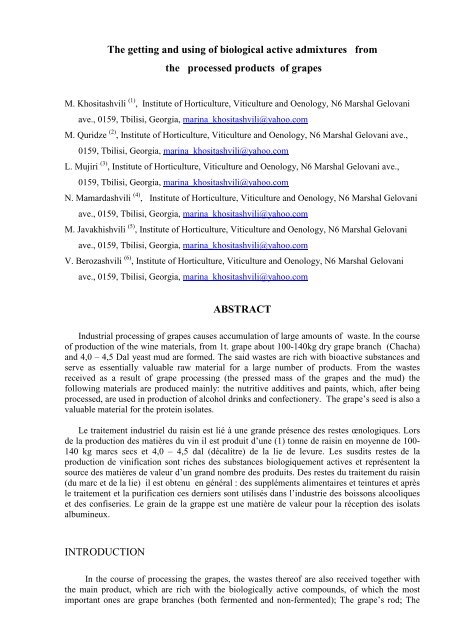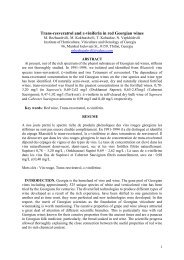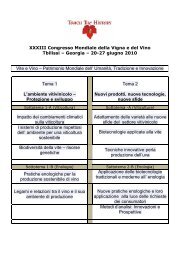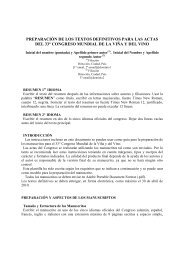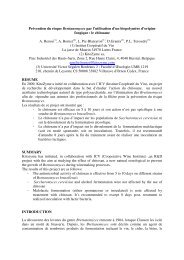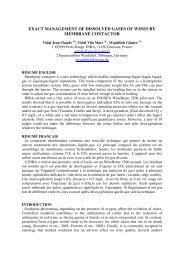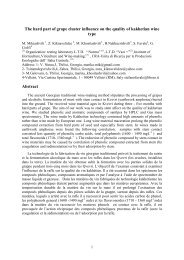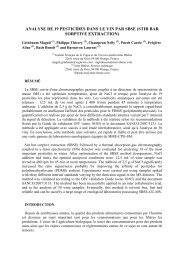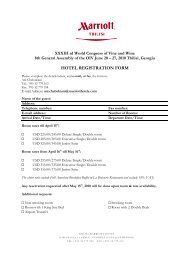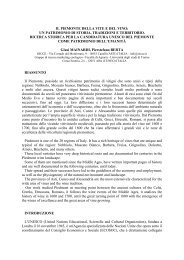P.II.52- narchenebi.pdf - Oiv2010.ge
P.II.52- narchenebi.pdf - Oiv2010.ge
P.II.52- narchenebi.pdf - Oiv2010.ge
Create successful ePaper yourself
Turn your PDF publications into a flip-book with our unique Google optimized e-Paper software.
The getting and using of biological active admixtures from<br />
the processed products of grapes<br />
M. Khositashvili (1) , Institute of Horticulture, Viticulture and Oenology, N6 Marshal Gelovani<br />
ave., 0159, Tbilisi, Georgia, marina_khositashvili@yahoo.com<br />
M. Quridze (2) , Institute of Horticulture, Viticulture and Oenology, N6 Marshal Gelovani ave.,<br />
0159, Tbilisi, Georgia, marina_khositashvili@yahoo.com<br />
L. Mujiri (3) , Institute of Horticulture, Viticulture and Oenology, N6 Marshal Gelovani ave.,<br />
0159, Tbilisi, Georgia, marina_khositashvili@yahoo.com<br />
N. Mamardashvili (4) , Institute of Horticulture, Viticulture and Oenology, N6 Marshal Gelovani<br />
ave., 0159, Tbilisi, Georgia, marina_khositashvili@yahoo.com<br />
M. Javakhishvili (5) , Institute of Horticulture, Viticulture and Oenology, N6 Marshal Gelovani<br />
ave., 0159, Tbilisi, Georgia, marina_khositashvili@yahoo.com<br />
V. Berozashvili (6) , Institute of Horticulture, Viticulture and Oenology, N6 Marshal Gelovani<br />
ave., 0159, Tbilisi, Georgia, marina_khositashvili@yahoo.com<br />
ABSTRACT<br />
Industrial processing of grapes causes accumulation of large amounts of waste. In the course<br />
of production of the wine materials, from 1t. grape about 100-140kg dry grape branch (Chacha)<br />
and 4,0 – 4,5 Dal yeast mud are formed. The said wastes are rich with bioactive substances and<br />
serve as essentially valuable raw material for a large number of products. From the wastes<br />
received as a result of grape processing (the pressed mass of the grapes and the mud) the<br />
following materials are produced mainly: the nutritive additives and paints, which, after being<br />
processed, are used in production of alcohol drinks and confectionery. The grape’s seed is also a<br />
valuable material for the protein isolates.<br />
Le traitement industriel du raisin est lié à une grande présence des restes œnologiques. Lors<br />
de la production des matières du vin il est produit d’une (1) tonne de raisin en moyenne de 100-<br />
140 kg marcs secs et 4,0 – 4,5 dal (décalitre) de la lie de levure. Les susdits restes de la<br />
production de vinification sont riches des substances biologiquement actives et représentent la<br />
source des matières de valeur d’un grand nombre des produits. Des restes du traitement du raisin<br />
(du marc et de la lie) il est obtenu en général : des suppléments alimentaires et teintures et après<br />
le traitement et la purification ces derniers sont utilisés dans l’industrie des boissons alcooliques<br />
et des confiseries. Le grain de la grappe est une matière de valeur pour la réception des isolats<br />
albumineux.<br />
INTRODUCTION<br />
In the course of processing the grapes, the wastes thereof are also received together with<br />
the main product, which are rich with the biologically active compounds, of which the most<br />
important ones are grape branches (both fermented and non-fermented); The grape’s rod; The
must released from the mud after settling and alcoholic distillation, as well as in the course of<br />
wine maturation; The mud received as a result of pasteurization, sulphatization, cooling and<br />
production of the grape juice; Grains (distillery refuse) - as a result of distillation of the wine<br />
material.<br />
A high content of the free fat acids and glycerine is detected in the grape branch and seed,<br />
while in their extracts a number of biologically active substances are identified (Mudziri, 1988)<br />
The grape seed contains 22-56% of the total poly-phenols, 28-58% of leukoanthocytes, 67-<br />
68% catekhines and an important volumes of the gal and the coffee acids (Ribero-Gayon, et al.,<br />
1981)<br />
The issues related to a complex processing of the wine secondary waste and a relevant<br />
application thereof, has not been still studied-in duly. Such the complex processing of these<br />
materials can make the wine production ecologically safe.<br />
MATERIALS AND METHODS<br />
A purpose of the study was to receive the biologically active compounds from the<br />
secondary products (grape rod, branch, wine mud, grape grain) and their use in different fields of<br />
the National Economy.<br />
A task of the study was to determine a content of nitrogenous compounds in the secondary<br />
wine products and to establish their biological quality; To develop the means of separation from<br />
the secondary wastes the biologically active compounds and their products and the use thereof.<br />
The secondary grape- and wine products, namely – the wine mud and the grape grain<br />
(distillery refuse) were selected as the objects of the study. Besides, the alcohol was isolated<br />
from the fermented grape branch. Thereafter, these secondary products underwent a process of<br />
drying and segregation and the biologically active substances were extracted from them and<br />
concentrated.<br />
A thickened mass of the hydrolyse received by use of the fermentation apparatus for<br />
malising the processed wine mud, is a protein-vitamin concentrate containing up to 50% soluble<br />
proteins and considerable amounts of amino-acids and vitamins. According to the above<br />
mentioned results, it is possible to use the said protein-vitamin concentrate as a stimulator for<br />
plants growing.<br />
For receiving the alcohol and the tartaric acid’s lime from the liquid mud, we conducted the<br />
distillation of the same and extracted the grains from the tartaric acid-containing compounds.<br />
As to the paste-like mud, it was first diluted in the water and mixed intensively, while the<br />
received liquid mass was used for distillation of the alcohol and extraction of the tartaric acid’s<br />
compounds.<br />
The wine mud of the “Rkatsiteli” grape sort being fully fermented, was used by us as the<br />
object of study. We have researched the wine mud until and after distillation of the alcohol and<br />
sedimentation of the tartaric acid’s salts. In order to separate the protein fractions from the yeast<br />
cells it became necessary to disintegrate the cell membrane through acidic hydrolyse of the wine<br />
mud. The protein-containing components were determined by a method (Pavlenko et al. 1968),<br />
during which we received the proteins soluble in water, salt, alcohol, and alkaline, while their<br />
quantitative in single fractions of the protein were determined by the Gartre method, and the<br />
total nitrogen content – by the Keldal method.<br />
RESULTS AND DISCUSSION<br />
As revealed, the wine mud after distillation of alcohol and sedimentation of the tartaric<br />
acid’s salts, the wine mud contains the protein substances with a total quantity up to 23%.<br />
We have researched also the grape seed’s nitrogenous substances, namely – the proteincontaining<br />
and not containing nitrogen, globulins, albumins, amino-acids. The seeds of the grape
sorts of “Saperavi”, “Rkatsiteli” and “Kaberne” being in the technical maturity phase were<br />
selected as the object of research.<br />
From the secondary wine products, namely, from the pressed mass of the grapes and the<br />
mud (both white and red) we have received the natural herbal paints containing the colourless<br />
leukoanthocyanides.<br />
The technology of comprehensive processing of the wine products waste envisages<br />
production of the protein-enriched and biologically active food products from the dry yeast<br />
refuse, the food flour, the grape seed and the grape branch (Razuvaev et al., 1985).<br />
Production of the protein-containing foods from the dry yeast is related to the energyconsumed<br />
and low-productive thickened yeast production processes. That is why, earlier, there<br />
were some attempts to use the yeast refuse as the food additive for animals. The content of the<br />
raw protein in the yeast refuse does not exceed 2,5% of the mass weight, while a total content of<br />
the dry substance makes 9-12% of the mass weight. A nutritive value of the yeast refuse is about<br />
0,5 on per 1 dl (Razuvaev, 1975). In most of wineries of Georgia, the grape branch is used<br />
mainly for livestock feeding and placed in the distillatory tanks. Distillation is carried out<br />
through the apparatus of NDT-3M model. Thereafter, the alcohol-free branches are to be shipped<br />
to the mixed fodder enterprises.<br />
We think that the primary wineries are able to produce the food products rich with<br />
bioactive compounds from the grape branches, distillery refuse of the thickened yeast and, use<br />
them for animal feeding purposes.<br />
In order to develop the technology for production of the food products enriched with the<br />
bioactive compounds, certain experimental works became necessary to conduct, giving us an<br />
opportunity to determine an optimal composition of the food products, the regimes of<br />
preparation thereof, the parameters of the relevant processes and, to carry out a test of<br />
experimental feeding of animals.<br />
In the course of the experimental works we used the fermented grape branches (pH 5,<br />
Tartaric Acid content – 0,1%, alcohol content – 2,5%) The grape branches were distilled on<br />
95°C and, being heated up to 58-60°C, and re-loaded into the thermally insulated reservoir which<br />
was preliminarily filled with the weed. The food value rate of the alcohol-free grape branch<br />
made 0,15 unit.<br />
For receiving the suspension, the dry mud of the yeast was mixed with the water up to 10%<br />
of the mass weight. The received blend was then distilled, while the distillery refuse received<br />
was delayed for 12 hours. After filtration, the received thickened refuse (pH 3,2; t=85°C)<br />
contained dry substances in amount of 10% of the mass weight and 2% tartaric acid. The<br />
nutritive value (rate) of the yeast refuse was 0,1 unit. The grape branches placed in the<br />
reservoir, were added to the hot yeast refuse in various ratios and mixed. During the whole<br />
period of storage in the reservoir, i.e. for 3 – 7 days, the temperature level was preserved<br />
constant - 58±2°C. The nutritive value of the product made 0,1 unit. A permissible period of<br />
storage of the product in natural conditions was determined after thermostating, depending upon<br />
the sample’s state. The food products unloading was organized through using the containers<br />
arranged on the trucks, with their further distribution to the livestock farms. A food made of the<br />
yeast mud and the flour with 91% moisture content, was used as the sample for the control<br />
testing purposes.<br />
A comparison of the results of analysis of the experimental food prepared for testing and<br />
the one used for control testing, proved that the food proposed by us has much higher quality and<br />
nutritive value and is much better by view of content of the bioactive substances, than the<br />
control sample. In the experimental food, a content of the raw protein is by 12,5% higher, while<br />
a total content of the nitrogen-free extracts exceeds the control one by about 19%
Bibliography<br />
1. Mudziri L. 1988. Niektore aspekty bezodpadovej technologie spracovania vedl’ajsich<br />
produktov pri vyrobe hrozna a vina //Kvas. prum. C.10. S.296-300<br />
2. Ribero-Gsyon J., Peino E., Ribero-Gayon P., Sudrou P. 1981 The Wine-Making Theory<br />
and Practice. V. 4 M. Food Indistry. p.352<br />
3. Razuvaev N. 1975. Combined Processing of the Wine Secondary Products. M. Food<br />
Industry. p. 168<br />
4. Razuvaev N., Melyaev V., Martinenko E., Zankal T., Selezneva L., Belan V., Vasilieva L.<br />
1985. Rational Technology of Receiving the FQI from Yeast Mud // Wine-making and<br />
Viticulture in the USSR, No. 1, p.19-21<br />
5. Pavlenko N., Datuashvili E. 1968. On Fermenting Hydrolyse of the Grapes Protein //<br />
Wine-making and Viticulture in the USSR, No.5, p.6-8


